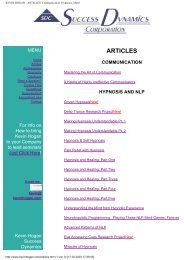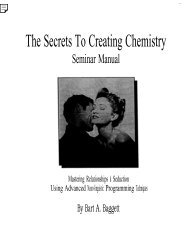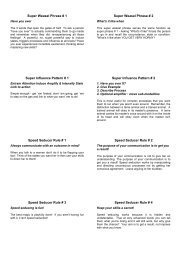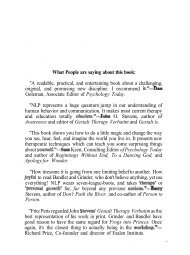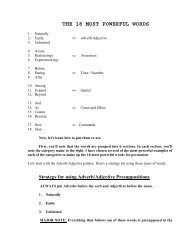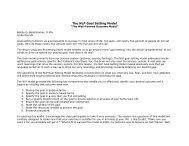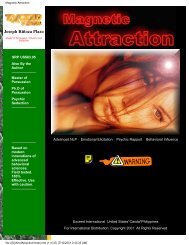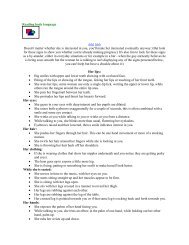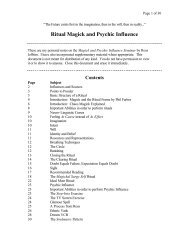A Pragmatic Guide To Communication & Change.pdf - NLP Info Centre
A Pragmatic Guide To Communication & Change.pdf - NLP Info Centre
A Pragmatic Guide To Communication & Change.pdf - NLP Info Centre
- No tags were found...
Create successful ePaper yourself
Turn your PDF publications into a flip-book with our unique Google optimized e-Paper software.
the way to or from the central nervous system as well as within it. Neural<br />
"messages" are also transmitted to muscles and glands through the axon terminal.<br />
i. 1111i, alao,<br />
Because sensory organs vary greatly from one individual to another, each one of us<br />
perceives the world differently. These differences may be subtle or great. But since our<br />
perceptions form the basis for our models of the world, we must assume that every<br />
individual will have a different model.<br />
CHAPTERI<br />
MODELS<br />
The purpose of the model is to enable the user to do a better job in handling the<br />
enormous complexities of life. By using models, we see and test how things work<br />
and can even predict how things will go in the future. (p. 13)<br />
Edward T. Hall Beyond Culture<br />
The Use of Models<br />
No other creature we know of is quite as infatuated with the construction and use of<br />
models as we humans appear to be. As Hall points out, "We are the model-making<br />
organism par excellence." (p. 13) We use these models to represent almost all aspects of<br />
our environment, our social organizations, our technology, and even our very life<br />
processes. Models of machines, buildings, or bridges help us see and evaluate design and<br />
structure. Models of government enable us to understand complex systems of human<br />
social behavior. Scientific models assist us in perceiving relationships and properties of<br />
theoretical problems and processes.<br />
viii<br />
Chapter III: The Meta Model .. . . . ...... . .. .. 68 The Digital Representational<br />
System ............ 68 -Symbolic representation<br />
-Analog/digital: the computer metaphor -Linguistic Deconditioning<br />
The Meta Model: Overview . ........ .. .... . 72 -Transformational grammar<br />
-Meto Model violations -Meta Model responses<br />
Gathering <strong>Info</strong>rmation .... . ............... 76 -Referential index<br />
-Nominalizations -Unspecified verbs<br />
Expanding Limits ............................... 92 -Modal operators<br />
-Universal Quantifiers<br />
Changing Meanings ............................. 99 -Mind reading<br />
-Cause and effect -Lost performative<br />
Summary ........................................ 110<br />
Chapter IV: The Visual Model ....... . 11,i Pupil<br />
Response .. .............................. 11:5 -The visual<br />
system<br />
Ocular Accessing Cues .. ...................315



